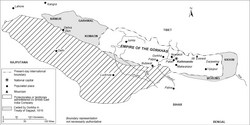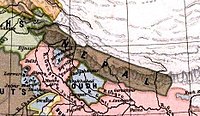
Back Горкха (дзяржава) Byelorussian गोरखा राज्य Bihari Königreich Gorkha German Reino Gorkha Spanish गोरखा राज्य Hindi Kerajaan Gorkha ID ゴルカ王国 Japanese 고르카 왕국 Korean गोरखा राज्य Nepali گورکھا سلطنت PNB
Kingdom of Gorkha गोरखा राज्य Gōrakhā Rājya | |||||||||
|---|---|---|---|---|---|---|---|---|---|
| 1559–1768 | |||||||||
 Territory, expansion and vassals states of Gorkha Empire. | |||||||||
| Status | Confederation[1] later Kingdom | ||||||||
| Capital | Gorkha | ||||||||
| Common languages | Khas (later Nepali) Newar[2][3][4][a] | ||||||||
| Religion | Hinduism | ||||||||
| Government | Monarchy | ||||||||
| Māhārājādhirāj | |||||||||
• 1559–1570 | Dravya Shah (first) | ||||||||
• 1743–1768 | Prithvi Narayan Shah (last) | ||||||||
| Sardar | |||||||||
• 1767–1771 | Ram Krishna Kunwar (first and last) | ||||||||
| History | |||||||||
• Established | 1559 | ||||||||
• Disestablished | 1768 | ||||||||
| Currency | Mohar | ||||||||
| |||||||||
| Today part of | Nepal | ||||||||
| History of Nepal |
|---|
 |
|
|
The Gorkha Kingdom,[b] also known as the Gorkha Confederation[c] or the Gorkha Empire,[d] was a member of the Chaubisi rajya, a confederation of 24 states, located at the intersection of Himalayas and the Indian subcontinent. In 1743, the kingdom began a campaign of military expansion, annexing several neighbors and becoming present-day Nepal.[1]
The Gorkha Kingdom extended to the Marshyangdi River in the west, forming its border with the Kingdom of Lamjung. To the east, the kingdom extended to the Trishuli River, forming its border with the Nepal Mandala.[6] The Gorkha Kingdom was established in 1559 CE by Prince Dravya Shah, the second son of King Yasho Brahma Shah of Lamjung. Dravya Shah replaced the Magar King Mansingh Khadka Magar who previously ruled the region.[7]
- ^ a b Hamilton, Francis Buchanan (1819). An Account of the Kingdom Of Nepal and of the Territories Annexed to This Dominion by the House of Gorkha. Edinburgh: Longman. Archived from the original on 13 November 2012. Retrieved 12 January 2013. Page 237.
- ^ Nepal Bhasa Sahityaya Itihas: History of Nepalbhasa Literature.Tuladhar, Prem Shanti (2000). Kathmandu: Nepal Bhasa Academy. ISBN 99933-56-00-X. Page 37: "The early new rulers cultivated Newari language. Kings Prithvi Narayan Shah, Rana Bahadur and Rajendra Bikram Shah composed poetry and wrote many plays in Newari".
- ^ Levy, Robert I. (1990) Mesocosm: Hinduism and the Organization of a Traditional Newar City in Nepal. Delhi: Motilal Banarsidass Publishers. ISBN 81-208-1038-4. Page 15:"Following the advent of the Shahs, the Gorkhali language became the court language, and Newari was replaced as the language of administration".
- ^ Malla, kamal. History of the Nepal. Kathmandu, Nepal: Rolwaling press. p. 155
- ^ Lienhard 1992, p. 3.
- ^ Kirkpatrick, Colonel (1811). An Account of the Kingdom of Nepaul. London: William Miller. Retrieved 12 January 2013. Page 123.
- ^ Marie Lecomte-Tilouine (Senior Researcher, Anthropology) CNRS, Paris, France. "The Enigmatic Pig: On Magar Participation in the State Rituals of Nepal, pp. 81-120 in M. Lecomte-Tilouine: Hindu Kingship, Ethnic Revival and Maoist Rebellion in Nepal. Delhi: Oxford University Press, "Collected Essays", 2009, 294 p". Oxford University Press.
{{cite web}}: CS1 maint: multiple names: authors list (link) - Page 85, p.95
Cite error: There are <ref group=lower-alpha> tags or {{efn}} templates on this page, but the references will not show without a {{reflist|group=lower-alpha}} template or {{notelist}} template (see the help page).

